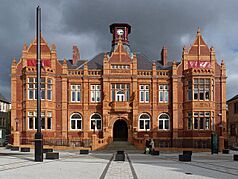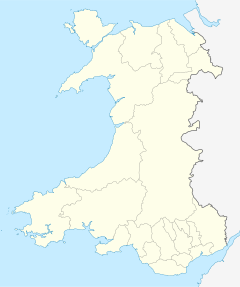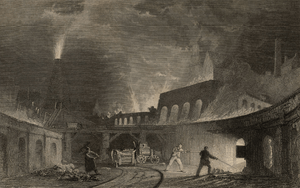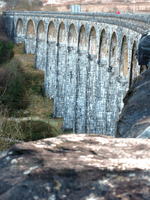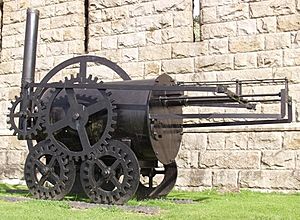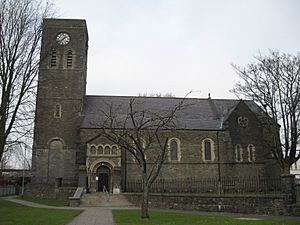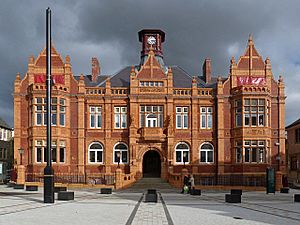Merthyr Tydfil facts for kids
Quick facts for kids Merthyr Tydfil
|
|
|---|---|
| Town | |
|
|
|
| Population | 43,820 (2011 Census) |
| OS grid reference | SO 0506 |
| Principal area |
|
| Ceremonial county | |
| Country | Wales |
| Sovereign state | United Kingdom |
| Post town | Merthyr Tydfil |
| Postcode district | CF47/CF48 |
| Dialling code | 01685 |
| Ambulance | Welsh |
| EU Parliament | Wales |
| UK Parliament |
|
| Welsh Assembly |
|
Merthyr Tydfil (called Merthyr Tudful in Welsh) is a major town in Merthyr Tydfil County Borough, Wales. It is located about 23 kilometres north of Cardiff. People often just call it Merthyr. The town is believed to be named after a girl named Tydfil. Legend says she was the daughter of King Brychan and was killed by pagans around 480 CE. The Welsh word Merthyr means "martyr". Here, it refers to a place of worship built over a martyr's relics. Other places in south Wales with similar names include Merthyr Cynog and Merthyr Dyfan.
Merthyr Tydfil is famous for its industrial past. In the early 1800s, it was known as the 'Iron Capital of the World'. This was because it produced so much iron. The world's first steam-powered train journey happened here in 1804. It travelled 9 miles from the ironworks at Penydarren to the Glamorganshire Canal. In 1851, Wales became the world's first industrialised nation. More people worked in factories than on farms. Merthyr was the biggest town in Wales at that time.
Today, the area is known for its industrial history and exciting adventure tourism. Merthyr has Cyfarthfa Castle, which is a Grade-I listed building. It also has the world’s fastest seated zip line and the UK's largest mountain bike park. You can find the biggest indoor climbing wall in Wales here too. There are national cycle routes and plans for the UK's longest indoor ski slope.
Contents
- Exploring Merthyr Tydfil's Past
- The Welsh Language in Merthyr
- Merthyr's Industrial Legacy
- Open-Cast Mining
- How Merthyr is Governed
- Religion in Merthyr
- Merthyr's Culture and Arts
- Tourism and Attractions
- Getting Around Merthyr
- Jobs in Merthyr
- Sports and Fun
- Schools in Merthyr
- Famous People from Merthyr
- Town Twinning
- See also
Exploring Merthyr Tydfil's Past
Ancient Times in Merthyr
People from Europe started living in this area thousands of years ago. We know this from old tools and remains found by archaeologists. Around 1000 BCE, the Celts arrived. Their language eventually became the Welsh language. During the Iron Age, people built hillforts. The tribe living in south Wales was called the Silures. This is according to Tacitus, a Roman historian.
The Romans Arrive in Wales
The Romans came to Wales between 47 and 53 CE. They built many forts and roads to connect them. They had to fight hard to take control. In 74 CE, they built a fortress at Penydarren. It overlooked the River Taff and covered about three hectares. Remains of this fort were found under the Merthyr Town F.C. football ground. A road ran through the area, linking the coast to Mid Wales. You can still find parts of these old Roman roads today.
The Silures fought bravely against the Romans from their mountain strongholds. But the Roman army eventually won. After a while, things became peaceful. The Penydarren fortress was left empty around 120 CE. This was tough for the local people. They had relied on selling food to the fort. Many Roman soldiers had also married local women and settled on farms.
As the Roman Empire grew weaker, their soldiers left Britain around 380 CE. By 402 CE, most of the Roman army in Britain was made up of local people. The best soldiers had gone back to Europe. During this time, Irish and Picts attacked Hadrian's Wall. Irish pirates also raided the coasts of Wales. By the mid-400s, Irish settlements were set up in places like Swansea and Pembrokeshire.
Christianity Comes to Wales
The Latin language and some Roman ways became common before the Romans left. The Christian religion was brought to Wales by the Romans. But in Merthyr, it might have come later. Monks from Ireland and France travelled into the area, following rivers and valleys.
Local Legends and Tydfil
Local stories say that around 480 CE, a girl named Tydfil lived here. She was the daughter of a local leader named Brychan. Tydfil was one of the first Christians in the area. She was supposedly killed by Welsh or Saxon pagans. She was buried in the town. After her death, she was seen as a martyr. The town was named Merthyr in her honour. A church was later built where she was believed to be buried.
The Normans Arrive
For many centuries, the River Taff valley was covered in thick forests. Only a few farms were scattered on the mountain slopes. Norman lords came after the Norman Conquest of England. But by 1093, they only controlled the lower lands. The Welsh rulers kept control of the uplands. There were many fights between the Norman lords and Welsh princes. Control of the land often changed hands in the Welsh Marches. During this time, Morlais Castle was built about two miles north of the town.
Early Merthyr Life
Merthyr did not become a permanent settlement until the Middle Ages. People lived by farming and trading. Merthyr was just a small village. There was an ironworks here in the Elizabethan period. But it closed by the 1640s. In 1754, records show that the valley was mostly home to shepherds. Farmers traded their goods at markets and fairs, like the Waun Fair.
The Industrial Revolution Begins
Iron Industry Grows Strong
Merthyr was perfect for ironworks. It had lots of iron ore, coal, limestone, wood, and water nearby. Small-scale iron working had been done in South Wales since the Tudor period. But during the Industrial Revolution, the demand for iron exploded. Merthyr's iron production grew very quickly. At its peak, Merthyr had four of the biggest ironworks in the world: Dowlais Ironworks, Plymouth Ironworks, Cyfarthfa Ironworks and Penydarren. Two powerful families, the Guest and Crawshay families, owned most of these companies.
In the late 1740s, land in Merthyr was leased for iron smelting. By 1759, the Dowlais Ironworks was founded by John Guest. This became the first major ironworks in the area. After its success, Guest started the Plymouth Ironworks. Then, Anthony Bacon leased a large area and started the Cyfarthfa Ironworks. He also bought the Plymouth Works. After Bacon died in 1786, his works were split between Richard Hill and Richard Crawshay. The fourth ironworks, Penydarren, was built by Francis Homfray and his son Samuel Homfray in 1784.
To transport goods from Cyfarthfa, the Glamorganshire Canal was built. It ran from the ironworks all the way to Cardiff Bay. This helped other businesses grow along the canal.
In the early 1800s, the ironworks at Cyfarthfa and Dowlais kept growing. They became the most productive ironworks in the world. In 1844, one ironworks alone sent 50,000 tons of rails to Russia. As industry grew in Merthyr, several railway companies built lines. These included the Brecon and Merthyr Railway and the Taff Vale Railway. They often shared tracks to reach coal mines and ironworks. Building these railways through the mountains was a huge challenge.
In 1804, the world's first steam locomotive, "The Iron Horse," was built by Richard Trevithick. It pulled 10 tons of iron and passengers on the new Merthyr Tramroad. This was from Penydarren to Quakers Yard. Some say this was the very first railway. A copy of this locomotive is in the National Waterfront Museum in Swansea. The tramway also went through what might be the oldest railway tunnel in the world. The demand for iron was also high because the Royal Navy needed cannons for its ships. Later, railways needed a lot of iron too. In 1802, Admiral Lord Nelson visited Merthyr to see cannons being made.
Life in the China District
In the 1800s, there was a poor area in Merthyr Tydfil called China. It was not a "Chinatown" as we know it today. Most people living there were English, Irish, and Welsh. People saw the residents of China as a separate group. They were known for their difficult living conditions.
About 1,500 people lived in this area. They were some of the poorest in Britain. The houses were crowded, and the streets were narrow and poorly ventilated. This led to many diseases. China was sometimes called "Little Hell" because of the tough conditions.
The Merthyr Rising
The Industrial Revolution brought many young men from farms to work in factories. They earned higher wages there. But in 1829, a difficult economic time hit Merthyr hard. Ironmasters cut wages and fired workers. Any sudden drop in the market caused great hardship for workers. This made the differences between rich and poor even bigger.
The Merthyr Rising of 1831 happened because of harsh debt collection and wage cuts. Some workers were paid with special coins or credit notes called "truck." These could only be spent at shops owned by their employers. Many workers did not like the prices or quality of goods in these shops. In May 1831, coal miners and other workers protested in Merthyr Tydfil. They wanted changes and protested against lower wages and job losses.
Between 7,000 and 10,000 workers marched. For four days, officials and ironmasters were trapped in the Castle Hotel. The protesters controlled the town. Soldiers from Brecon arrived and fought with the rioters. Several people on both sides were killed. Some leaders of the riots were arrested. One of them, Richard Lewis, known as Dic Penderyn, was hanged. He became known as a working-class hero. Some people later claimed he was innocent.
The Pen-y-Darren Locomotive
In 1802, Homfray, who ran the Penydarren Ironworks, asked engineer Richard Trevithick to build a powerful steam engine. Trevithick, with help from Rees Jones, put the engine on wheels. This turned it into a locomotive. In 1803, Trevithick sold the rights to his locomotives to Homfray.
Homfray was so impressed that he made a bet. He bet that the locomotive could pull 10 tons of iron along the Merthyr Tramroad. This was a distance of 9.75 miles from Penydarren to Abercynon. On 21 February 1804, with many people watching, it successfully carried 11.24 tons of coal, five wagons, and 70 men. It completed the journey in 4 hours and 5 minutes, averaging 2.4 miles per hour. This event showed that steam trains could work. It helped others develop Trevithick's ideas. Some say the modern railway system began in Merthyr Tydfil. A working copy of this locomotive is in the National Waterfront Museum in Swansea.
The Decline of Coal and Iron
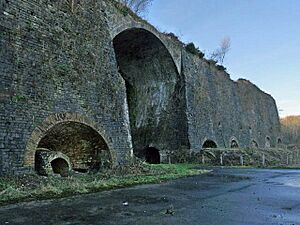
Merthyr's population reached 51,949 in 1861. But then it started to shrink. As the 1800s went on, Merthyr's location inland became a problem for iron production. Penydarren closed in 1859, and Plymouth in 1880. Some ironworkers moved to the United States or even Ukraine. There, Merthyr engineer John Hughes started an ironworks in 1869, creating the new city of Donetsk.
In the 1870s, coal mining began south of the town. This boosted the local economy and population again. New mining towns grew at Merthyr Vale and Treharris. Merthyr's population reached its highest point of 80,990 in 1911. The town grew so much that it became a county borough in 1908.
The Cyfarthfa Ironworks is a good example of this decline. The owners did not want to switch from iron to steel production. They did not use the new Bessemer process. This led to the works closing in 1874. This caused many job losses and economic hardship in Merthyr.
After the owner Robert Crawshay died in 1879, his son William Thompson Crawshay took over. William finally updated the works and started making steel. But it took until 1882 to reopen. It never fully caught up with other steel-making areas and closed again in 1910. It reopened briefly during the First World War but closed for good in 1919. The local steel and coal industries declined after the war. By 1932, over 80% of men in Dowlais were unemployed. Many people left Merthyr in the 1920s and 1930s. Merthyr's luck improved during World War II as war industries came to the area.
After World War II
After the Second World War, several big companies came to Merthyr. In October 1948, the American-owned Hoover Company opened a large factory in Pentrebach. This factory made washing machines. At one point, Hoover was the biggest employer in the area. Later, the Sinclair C5 electric vehicle was also built there.
Hoover and other companies chose Merthyr because its old coal and iron industries were shrinking. This left space for new businesses. There were also many unemployed workers, including women after the war. Hoover started with 350 employees. By the mid-1970s, it had nearly 5,000 workers. This greatly helped the town after the decline of coal and iron.
More women found jobs in Merthyr after the war. This was because new light manufacturing and consumer goods companies opened. This was very different from the heavy industries that mostly hired men.
Other companies also built factories. Teddington Aircraft Controls, which made airplane parts, opened in 1946. It closed in the early 1970s. The Merthyr Tydfil Institute for the Blind, started in 1923, is the oldest active manufacturer in town.
Cyfarthfa Castle, the grand home of an ironmaster, is now a museum. It has paintings of the town and many items from the Industrial Revolution. It also has a collection of Egyptian artefacts, including sarcophagi.
In 1992, scientists were testing a new medicine in Merthyr Tydfil. They found that it had unexpected side effects that led to the development of another important medicine.
In 2006, inventor Howard Stapleton from Merthyr Tydfil created technology that led to the "mosquitotone" or Teen Buzz sound.
In September 2021, Merthyr Tydfil County Borough Council announced plans to apply for city status.
The Welsh Language in Merthyr
The number of people speaking Welsh in Merthyr dropped a lot in the late 1800s and 1900s. In 1891, 68.4% of people spoke Welsh. By 1911, it was 50.9%. The 2011 census showed 8.9% mainly spoke Welsh.
Merthyr Tydfil hosted the National Eisteddfod in 1881 and 1901. It also hosted the national Urdd Gobaith Cymru Eisteddfod in 1987. Merthyr has three primary schools where lessons are taught in Welsh. There are also calls for a Welsh-speaking secondary school.
Merthyr's Industrial Legacy
Merthyr was built on heavy industry. It became the 'Iron Capital of the World' and Wales's largest town in the early 1800s. But when heavy industry declined, Merthyr lost many jobs. This caused big economic problems, especially in the 1900s.
In 2006, a TV series ranked Merthyr Tydfil as the UK's third-worst place to live. In 2007, it improved to fifth-worst. However, there were complaints about the show's accuracy.
More recently, Merthyr has become more popular. This is due to renovation projects and growing tourism. In 2021, house prices in Merthyr Tydfil increased by 27.9%. This was the highest increase in Wales.
Cyfarthfa Castle, a large mansion built for the ironmasters, is now a museum and art shop. It attracts millions of visitors each year. There are plans for a £50 million renovation of the Castle and its area. This includes saving the 200-year-old Cyfarthfa furnaces.
Cefn Coed viaduct is the third largest in Wales. It is now a Grade II listed building. It is a beautiful part of the Taff Trail cycle path. This path links Cardiff to Brecon.
Merthyr Tydfil Town Hall has been given a new purpose. It is now an arts and creative industries centre. The building opened in 1896. It had an £8 million renovation that finished in 2014.
The YMCA building, which has four floors, is also being renovated. It was built in 1911 and will become a hub for economic and social activities.
Open-Cast Mining
In 2006, a large open-cast coal mine was approved east of Merthyr. This mine, called Ffos-y-fran, was planned to extract 10 million tonnes of coal over 15 years.
How Merthyr is Governed
The area of Merthyr Tydfil became a local board district in 1850. This became an urban district in 1894. In 1905, it became a municipal borough. Merthyr Tydfil was granted county borough status in 1908. This made it independent from Glamorgan County Council. From 1974 to 1996, it was a lower-level district council. Mid Glamorgan County Council provided county services. The borough also grew in 1974, adding Vaynor and Bedlinog.
In 1996, Mid Glamorgan County Council was removed. The borough council took over its duties. It was renamed Merthyr Tydfil County Borough Council. The council governs the town and the wider area. This area stretches south to Treharris and Bedlinog. The town includes areas like Park, Penydarren, Cyfarthfa, and Dowlais.
The Member of Parliament for the Merthyr Tydfil and Rhymney constituency is Gerald Jones. The Senedd member is Dawn Bowden MS.
Religion in Merthyr
Anglican Churches
In the 1800s, Merthyr was known for its many nonconformist chapels. But these chapels declined quickly from the 1920s onwards. Most are now closed.
The Church of England (now the Church in Wales) tried to balance the influence of nonconformity. Merthyr had several important priests. One was John Griffith, who was rector from 1858 to 1885. He supported the idea of separating the Church from the State. His funeral was attended by thousands of people.
Another important person was Sir John Josiah Guest. He helped a lot with building St John's Church, Dowlais. This church was important in trying to balance nonconformity in Merthyr. In 2019, the church was turned into apartments.
Nonconformist Chapels
Merthyr was famous in the 1800s and early 1900s for its many nonconformist places of worship. Most of them held services in Welsh.
One of the oldest was Ynysgau Chapel, built in 1749. It was taken down in 1967. Other early chapels included Zion and Ebenezer (Baptists) and Pontmorlais (Calvinistic Methodists).
The Merthyr Jewish Community
Merthyr Tydfil had the largest Jewish community in Wales in the 1800s. It reached 400 people at its peak. As the Jewish population grew, the Merthyr Hebrew Congregation was founded in 1848. A cemetery was opened a few years later. Merthyr Synagogue was built in 1875. Religious services stopped when there were fewer than ten Jewish men, which is the minimum number needed for a service.
In 1978, the building was given a special historical listing. In the 1980s, the synagogue was sold and became a Christian Centre, then a gym. In 2009, permission was given to turn it into apartments. In 2019, the Foundation for Jewish Heritage bought it. They plan to open it as a Jewish Heritage Centre in 2025.
Merthyr's Culture and Arts
The town has many cultural events. Local poets and writers hold poetry evenings. Music festivals are organised at Cyfarthfa Castle and Park. Menter Iaith Merthyr Tudful (the Merthyr Tydfil Welsh Language Initiative) has turned the Zoar Chapel into a community arts venue. This is called Canolfan Soar and Theatr Soar. It offers performances and activities in both Welsh and English. It also has a cafe and a bookshop.
Merthyr Tydfil Housing Association and Canolfan Soar have raised money to make the Pontmorlais area a cultural hub. A new arts centre called Redhouse Cymru opened in Merthyr Tydfil Town Hall on Saint David's Day 2014. The town has several choirs, like Dowlais Male Voice Choir and Merthyr Tydfil Ladies Choir. They perform locally and abroad.
Merthyr has several groups that focus on history and heritage:
- Merthyr Tydfil Heritage Regeneration Trust works to save historical buildings and items.
- Merthyr Tydfil Historical Society promotes the study of local history and architecture.
- Merthyr Tydfil Museum and Heritage Groups support and improve the heritage of Merthyr Tydfil.
Merthyr's Central Library is a well-known building in the town centre. It is a Carnegie library. Merthyr hosted the National Eisteddfod in 1881 and 1901. It also hosted the national Urdd Gobaith Cymru Eisteddfod in 1987. The town is known for its music scene. Bands like The Blackout have become nationally successful. From 2011 to 2014, the town held a Merthyr Rock Festival. The town also holds the Merthyr Rising each year. This is a three-day celebration of the town's history through local music.
Tourism and Attractions
The town is on the southern edge of the Brecon Beacons National Park. It is also a good base for visiting the South Wales Valleys. The remains of Morlais Castle are on the northern edge of Merthyr Tydfil. This Norman castle was reportedly never finished. The Brecon Mountain Railway is a narrow-gauge tourist railway. It runs up the Taf Fechan valley from Pant.
Getting Around Merthyr
Train Travel
Transport for Wales (TfW) runs regular trains. These go from Merthyr Tydfil to Cardiff Queen Street and Cardiff Central.
A new railway station was built by 2024. This is part of the South Wales Metro upgrades. The new station helps connect Merthyr to the wider region. New overhead lines power new tram-trains. These reduce journey times to Cardiff and allow more frequent services.
Bus Services
Merthyr Tydfil bus station is on Swan Street. It opened in June 2021. Its new location is closer to the railway station. This makes it easier to switch between trains and buses.
Stagecoach South Wales operates bus services in the area. Routes connect Merthyr to places like Aberdare, Brecon, and Cardiff.
Road Connections
Road improvements have made Merthyr a good place for commuters. This has led to some of the highest house price growth in the UK.
Jobs in Merthyr
Merthyr's jobs come from the public sector, manufacturing, and service sector companies. The Welsh Government has a large office in the town. There is also a big telecommunications call centre (T-Mobile and EE). Hoover used to be a major employer. However, it moved its production abroad in March 2009. This resulted in 337 job losses.
Sports and Fun
Boxing Heroes
Merthyr is well known for its boxers. Famous professional boxers include Johnny Owen, Howard Winstone, and Eddie Thomas. Bronze sculptures in the town celebrate their achievements.
Football Teams
Merthyr has a football team called Merthyr Town, or The Martyrs. They play in the Southern Football League Premier South division. Their home games are at Penydarren Park.
The town used to have a professional Football League club, Merthyr Town F.C. (1909). It closed in the 1930s. Merthyr Tydfil AFC was founded in 1945. In 1987, it won the Welsh Cup. In 2010, the club faced financial problems. It changed its name back to Merthyr Town and moved grounds. After being promoted, the club returned to Penydarren Park in July 2011.
Rugby Teams
Rugby Union
Merthyr RFC, known as the Ironmen, was one of the 12 clubs that started the Welsh Rugby Union in 1881. They play in the Principality Premiership. Their home games are at The Wern.
Rugby League
Since 2017, the semi-professional League 1 club South Wales Ironmen plays in Merthyr. They play at Merthyr RFC's ground, The Wern. Merthyr is also home to the Tydfil Wildcats Rugby League team. Merthyr Tydfil was one of the first rugby league teams in Wales in 1907. They even beat the first Australian touring team in 1908.
Mountain Biking Adventures
Bikepark Wales is the UK's first special mountain biking centre. It is located at Gethin Woods, Merthyr Tydfil. It covers 1200 acres and has many different mountain bike trails for all weather.
Outdoor Activities
Parkwood Outdoors Dolygaer is an outdoor activity centre. It opened in 2015. You can go canoeing and stand-up paddleboarding on the Pontsticill Reservoir there.
Schools in Merthyr
The main secondary schools in the town are Afon Taf High School, Cyfarthfa High School, and Pen-Y-Dre High School.
Famous People from Merthyr
- Laura Ashley – a famous fashion designer.
- Des Barry – an author.
- Members of The Blackout – a rock band.
- William Berry, 1st Viscount Camrose – a newspaper owner.
- Nathan Craze – a professional ice hockey goalie.
- Gordon Davies – a Welsh international footballer.
- Richard Davies – an actor.
- Kevin Gall – a professional footballer.
- Sir Samuel Griffith – an Australian politician and the first Chief Justice of Australia.
- Gavin Gwynne – a professional boxer.
- Richard Harrington – an actor.
- John Hughes – a businessman who founded the city of Donetsk.
- Ciaran Jenkins – a broadcaster and journalist.
- Declan John – a professional footballer.
- Glyn Jones – a poet and novelist.
- Jack Jones - a miner and novelist.
- John Edward Jones – an American politician and Governor of Nevada.
- William Ifor Jones – an American conductor.
- Brian Law – a Welsh international football player.
- Chelsea Lewis – a Welsh international netball player.
- Peter Locke – a Welsh professional darts player.
- Julien Macdonald – a fashion designer.
- Man – a prog-rock band.
- Leslie Norris – a poet and short-story writer.
- Johnny Owen – a boxer.
- Jonny Owen – an actor and producer.
- Joseph Parry – a composer.
- Mark Pembridge – a Wales international football player.
- Robert Sidoli – a Welsh rugby international.
- Eddie Thomas – a boxer.
- Penry Williams – an artist.
- Howard Winstone – a boxer.
Other notable people who lived in Merthyr include poet and author Mike Jenkins. His son Ciaran and daughter Plaid Cymru politician Bethan Jenkins are also notable. Poet and journalist Harri Webb lived here. Mark Serwotka, General Secretary of the PCS trade union, is from Merthyr. Poet and author Meic Stephens and poet Grahame Davies also lived here. Andrew Haines, current head of Network Rail, is from Merthyr. Sam Hughes started his career as a musician in the Cyfarthfa Brass Band. One of the first two Labour MPs elected to parliament was Keir Hardie, for Merthyr Tydfil.
Famous descendants of people from Merthyr include singer-songwriter Katell Keineg. The mother of "Chariots of Fire" athlete Harold Abrahams was from Merthyr. The grandfather of Rolf Harris also had roots here. The 1970s music group The Osmonds traced their family history to Merthyr.
Lady Charlotte Guest, a publisher and translator, married ironmaster John Josiah Guest in 1833. She moved to his mansion in Dowlais. There, she translated the stories of the Mabinogion between 1838 and 1845.
Town Twinning
- Clichy, Hauts-de-Seine, France, since 1980.
See also
 In Spanish: Merthyr Tydfil para niños
In Spanish: Merthyr Tydfil para niños
- Sustainability in Merthyr Tydfil


